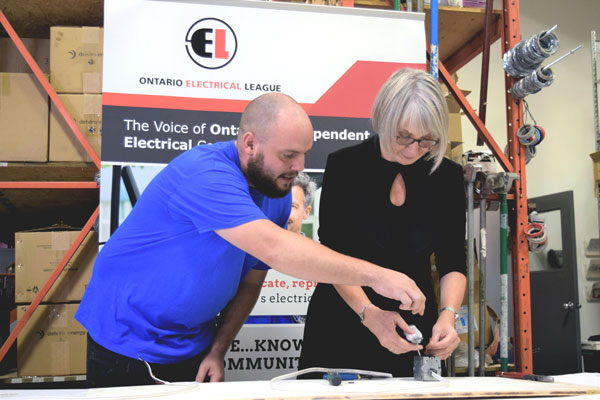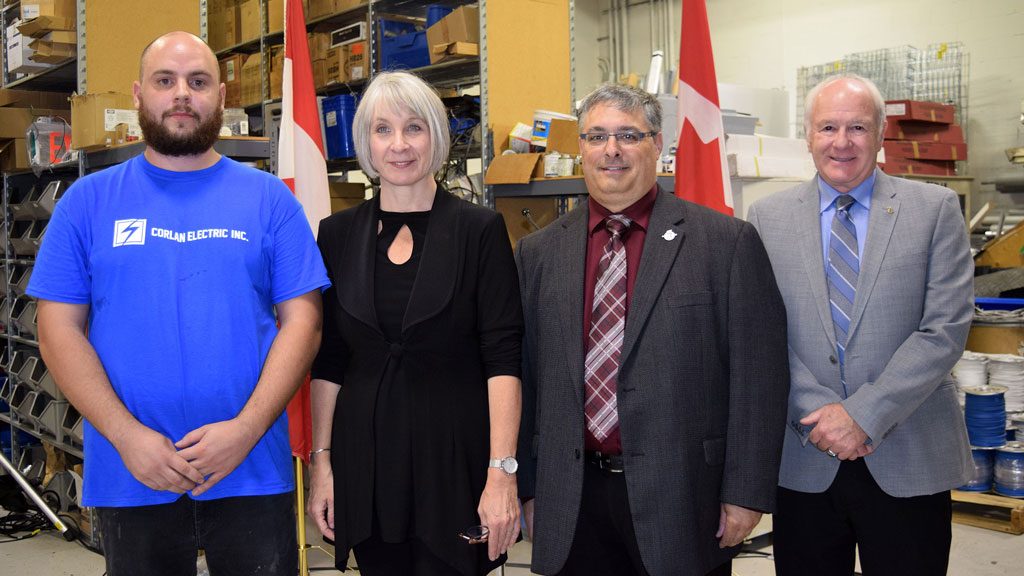The construction worker recruitment problem is at crisis level said federal Minister of Employment, Workforce Development and Labour Patty Hajdu during a visit to the offices of a Mississauga, Ont. electrical contractor recently.
Hajdu chose Corlan Electric as a backdrop to announce the federal government is providing $618,000 to the Ontario Electrical League (OEL) for the OEL’s new Consortia Pilot Project — Employer Engagement program. The program aims to support first-time employer participants in apprenticeship training.
There are currently 65,000 job openings in the skilled construction trades across Canada, Hajdu told Corlan staffers and OEL supporters on Sept. 21.
“We are at a crisis in the electrical trades, the building trades,” she said, listing issues such as the retirement of older workers, a lack of harmonization between provincial and federal regimes and the underrepresentation of groups such as women, youth and Indigenous Canadians.
Hajdu also commented on the “leap of faith” required among employers to make the investment — estimated at $100,000 by one contractor — to support a new apprentice through five years of training.
“We have a lot of work to do,” she said.
The employer engagement project will mesh with an existing program the OEL has undertaken with Support Ontario Youth, funded by the province, which OEL president Stephen Sell explained was launched two years ago with the goal of identifying suitable candidates for apprenticeships.
With the new funding, the OEL will identify and train employers who have never been involved in apprenticeship training, supporting a total of 20 employers and 20 apprentices. The program will be fine-tuned then expanded across the industry, Sell noted.
The focus of discussions is generally on bringing potential new apprentices into the industry, Sell said, but there are gaps to be overcome on the employer side as well. The new funding will be used for outreach and to create tools for employers, he explained.

“We have added extra resources to do outreach to employers, we have created a training program for employers,” he said. “There is a hiring tool that is going to help employers hire apprentices with the right skill set, and the final component of that is there are two employer mentors contributing on why it is a good idea to hire apprentices, so we walk them through the process and basically are there to coach, to help them work through the whole process.”
Some small employers think they don’t have the administrative resources to be able to register apprentices and track their 9,000 hours of training, Sell explained. He said employers can face between two days to three months of administration to get an apprenticeship underway, depending on the employer’s degree of sophistication.
OEL board member Dale MacDonald, with Chatham-based Honey Electric, drove up to Mississauga for the event to support the rollout of the new program.
“It is going to provide opportunities for us to convince employers, to give them some subsidies to help them get apprentices in,” he commented. “Many, many OEL members are smaller contractors and in the past they have been reluctant to take on apprentices, some of them see them as a burden. Some argue they see it as cheap labour and they don’t even sign them up as apprentices. That has been a problem in the past and it has to stop and this program will help that too.”
Another contractor attending the event, Brian Scheele of B-Safe Electric of Mississauga, said electrical work is unlike any other trade because the burden of training is so huge.
“It is very difficult for an employer to get a skilled worker because it is so much more complex than other trades,” he said.
“An electrical apprenticeship is five years and we jokingly say, it takes five years to get your licence and it takes 10 years to know what you’re doing, because it is such a complex industry.”
Sell, MacDonald and Scheele all said apprenticeship ratios, an issue regulated by the province, is the number-one problem the industry faces in recruiting new apprentices.
“I wish the federal people could work together with the provincial people,” said MacDonald. “We have been struggling for years to improve the ratios here in Ontario, it is the worst in North America.”
Hajdu commented, “It is not federal jurisdiction but I do have an opportunity to meet with my counterparts provincially once or twice a year and we talk not just about apprenticeships but other issues facing labour across country and I know there is lots of work happening within provinces to standardize some of the requirements for different professions. Certainly I will be bringing those comments back to that table.”









Maybe the problem has a foundation associated with apprentices working for minimum wage for a significant period of time. Sure, there is a carrot at the end of the stick, but that is one long stick. 9,000 hours where physical survival is impossible without assistance.
The wages are not enough to attract apprentices, there is a massive shortage of Skilled Trades Workers, there has to be a improved future plan above and beyond the Tony Dean Report which has proven to be a worthless investment.
We have the Ontario College of Trades that is a solid foundation for support of apprentices, Trades Workers and ensuring skilled workers are in Ontario for our future, we just need the employees, Union or Non Union,
Support Trades for Ontario’s Future.
Ben Stegner
None of these companies register their apprentices, electricians are kept at an artificially high value because no one is making more electricians.